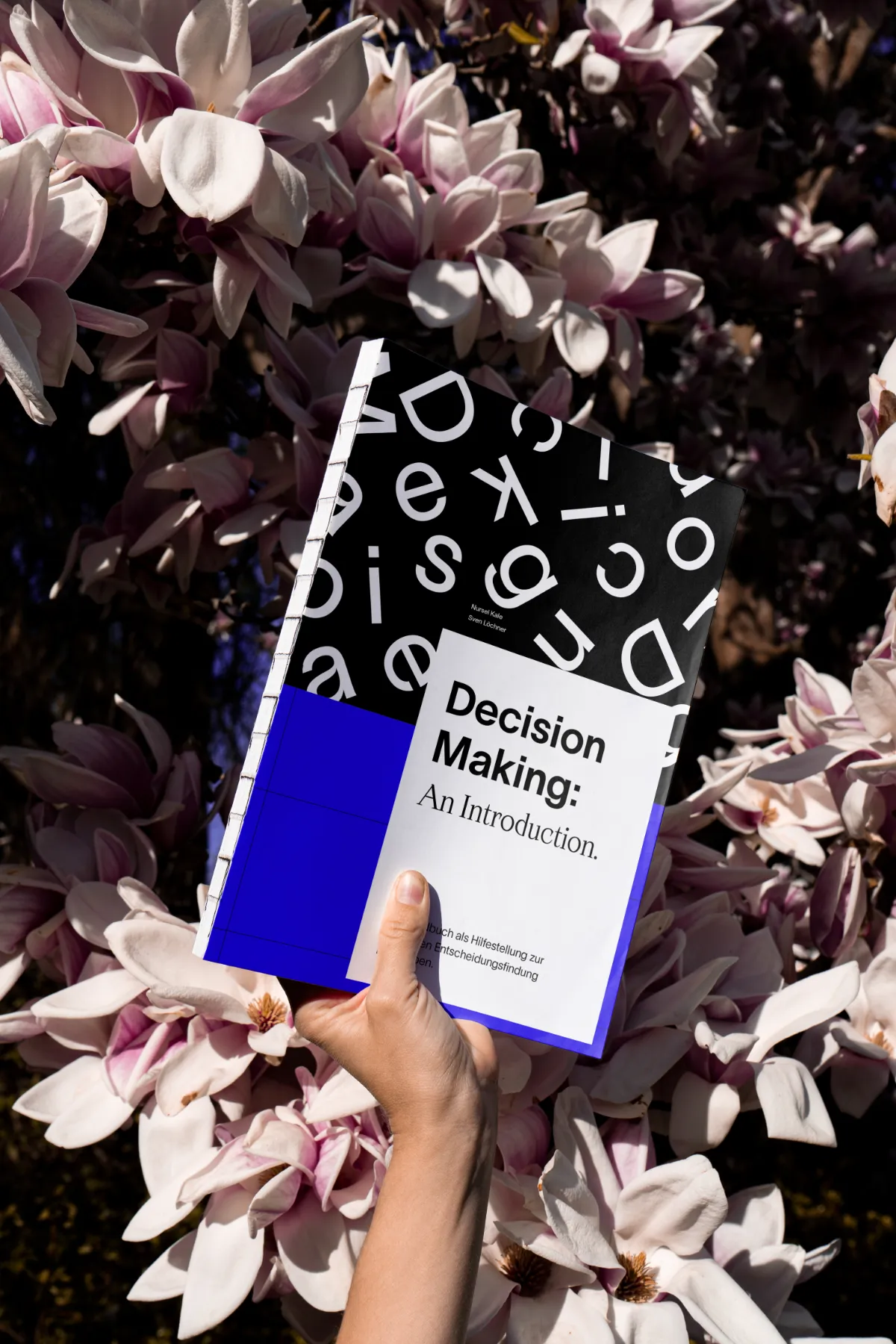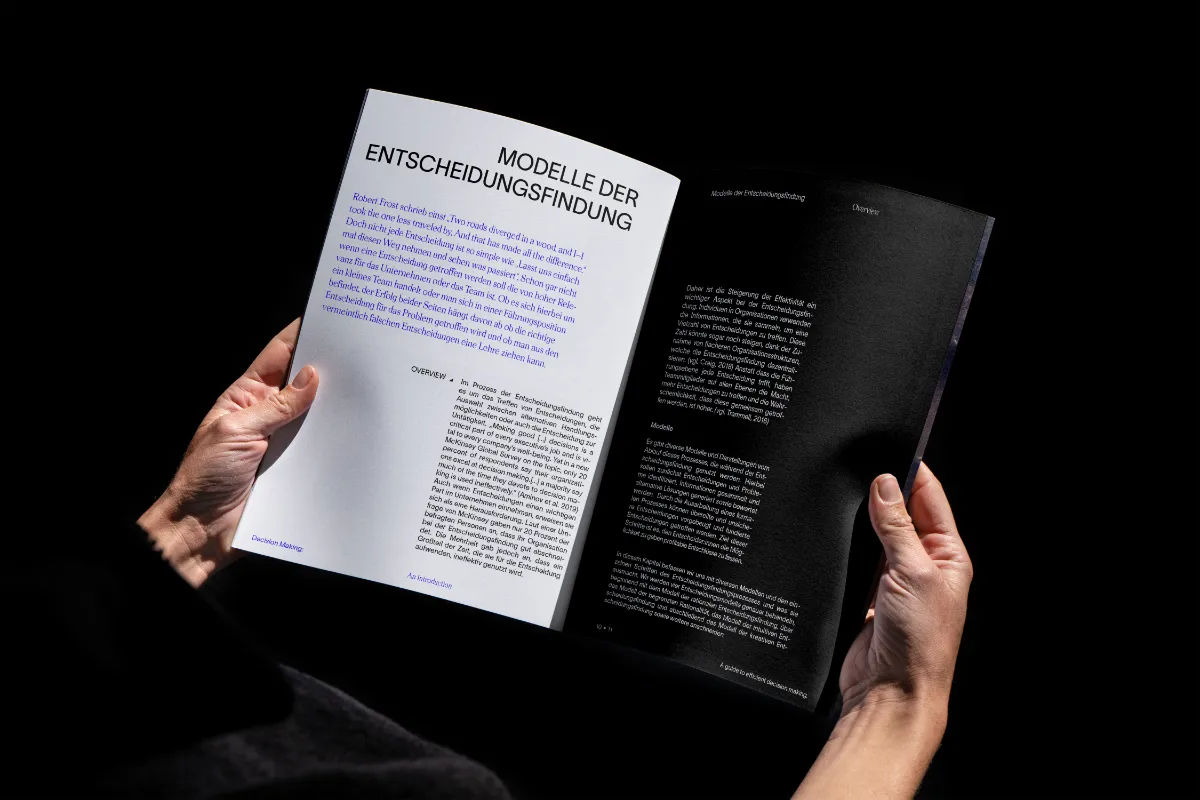Decision Making: An Introduction - A guidebook for efficient decision making in uncertain situations.

"The world is a messy place, where minor events can have large consequences." — Kahneman
The complexity of the world around us is constantly increasing. In everyday life, we have to make
decisions affecting the way we live, while future events cannot be predicted. Making efficient decisions
under these conditions means facing uncertainty and making robust choices.
The thesis Decision Making: An Introduction designs a practical approach to decision making in complex
situations under uncertainty. Decision makers and teams are provided with a foundational mindset
that uses established methodological approaches and reframes them through combination and flexible
application.
The focus of the work is on the decision-making process. The goal is to develop a framework for use
in organizational decision-making levels, and thereby to transfer the contents of theory into practice.
By combining three approaches, Design Thinking, Integrative Thinking and Liberating Structures, the
theoretical research of decision science is conveyed through practical methodologies.
In our thesis, we explored the topic of decision-making in a broad sense. The emphasis was on the decision-making process itself and how methodology and data can be used to make informed decisions. Our objective was to formulate a process that could lead to a robust decision in complex and uncertain situations. To achieve this, we divided our work into three parts. First, we created a theoretical companion book that provides in-depth explanations and serves as a reference guide. Second, we developed a set of cards that present and explain individual methods. These can be used by teams, for instance during a workshop. The third element is a website that compiles templates for workshops and further explanations of each method presented in the method cards.
Mission
How can we structure the process of decision-making and make it repeatable so that decision-makers are able to make efficient decisions even under uncertain circumstances?
Theory Book
The Decision-Making Theory Book provides the reader with an introduction to the theory of the
subject. Starting from the front, the contents are described in detail and summarize the
wide-ranging areas of decision theory and its research findings. Read from the back, the book
serves as a compact reference guide to individual topics.
Website
The Decision-Making Theory Website provides an overview of the entire framework. It contains
more detailed descriptions of the method cards, individual templates for widely used problems
in decision making, and summaries of important parts of the theory. It can be used
independently of the cards and book.
Methods and workshop
The methods deal with different aspects and needs and help to make decision making efficient
and gain a broader view of the problem.
Methodology
We strive to integrate different mindsets and combine them to form a robust decision making process. Methodologies and mindsets used in this project:
- Liberating Structures
- Agile
- Scrum
- Design Thinking
- Speculative Design
- Integrative Thinking

Multimedia Concept
Enabling different approaches to the topic and creating a bridge between theory and application.
The multimedia concept enables different approaches to the topic and creates a bridge between theory and application.
Notable influences
Gerd Gigerenzer is a German psychologist and author known for his work in the fields of cognitive psychology, decision-making, and heuristics. Gigerenzer is recognized for his research on the use of simple decision-making strategies, called heuristics, in human judgment and decision-making processes. He has argued that these heuristics, which rely on intuitive and efficient mental shortcuts, often lead to accurate decisions despite operating with limited information.
Reading recommendation: Risk Savvy: How to Make Good Decisions by Gerd Gigerenzer
Daniel Kahneman is an Israeli-American psychologist and economist. Kahneman is best
known for his pioneering work on human judgment and decision-making, particularly in the areas
of cognitive biases and prospect theory. Alongside Amos Tversky, his long-time collaborator
and friend, Kahneman conducted groundbreaking research that challenged traditional economic
theories assuming human rationality.
Their work demonstrated that individuals often deviate from rational decision-making due to cognitive
biases, such as the availability heuristic, anchoring bias, and framing effects. They showed that
people's judgments and choices are influenced by psychological factors that can lead to systematic
errors.
Reading recommendation: Thinking fast and slow by Daniel Kahneman
Roger L. Martin is a Canadian business strategist and author is widely recognized for his expertise in business strategy and design thinking. He has made significant contributions to the field through his research, writing, and consulting work. Martin emphasizes the importance of integrative thinking, a concept he developed, which involves the ability to hold opposing ideas and viewpoints in tension and develop creative solutions that transcend traditional trade-offs.
Reading recommendation: Creating Great Choices: A Leader's Guide to Integrative Thinking by Jennifer Riel & Roger L. Martin